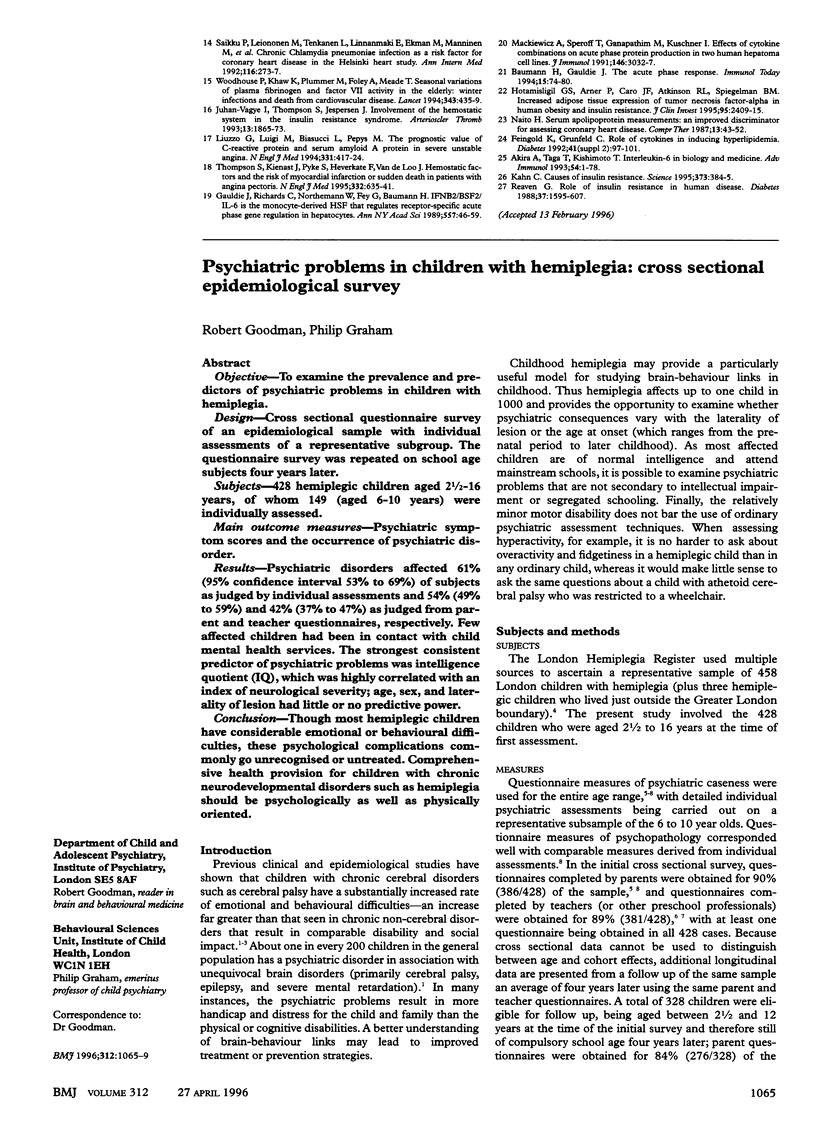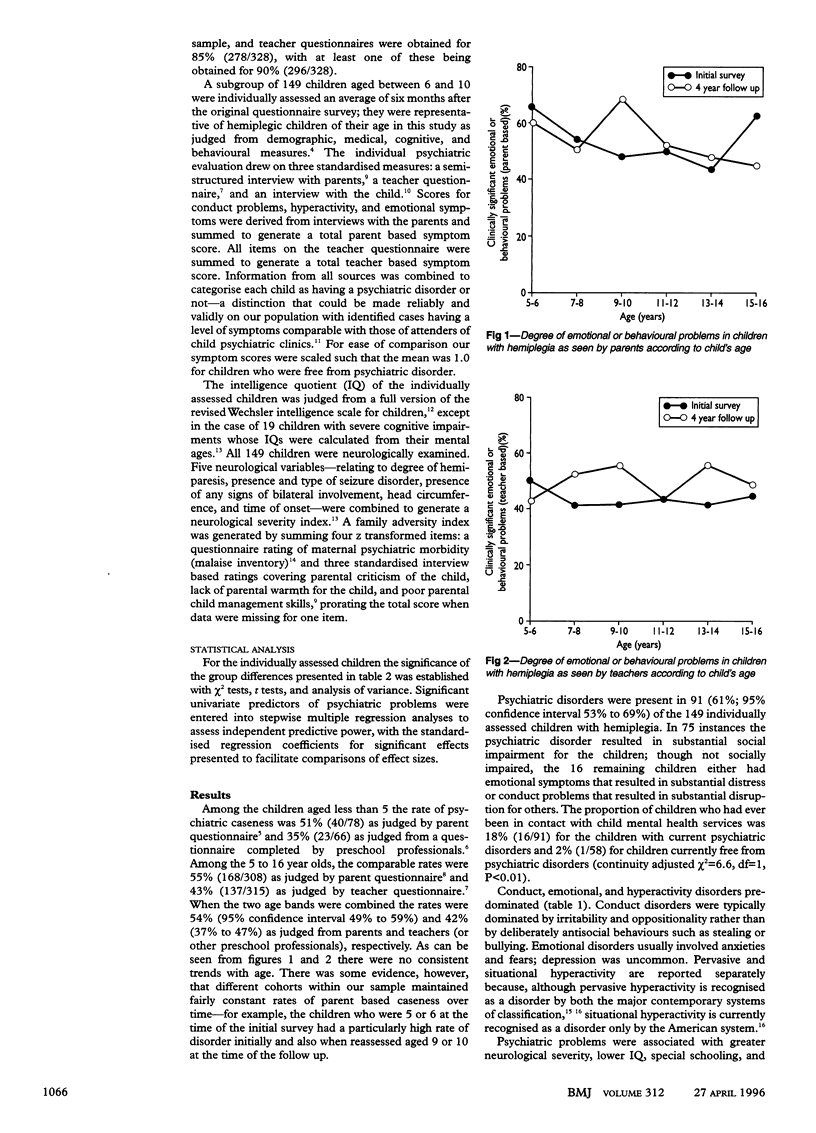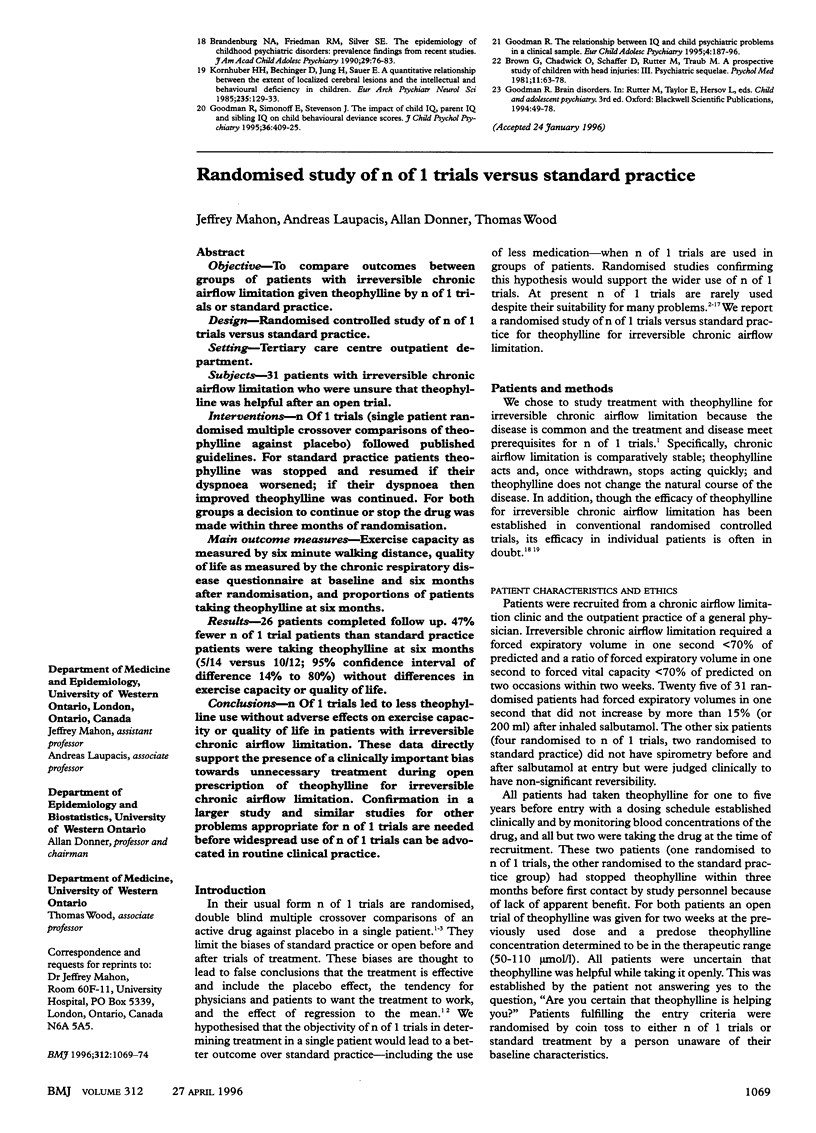Abstract
OBJECTIVE--To examine the prevalence and predictors of psychiatric problems in children with hemiplegia. DESIGN--Cross sectional questionnaire survey of an epidemiological sample with individual assessments of a representative subgroup. The questionnaire survey was repeated on school age subjects four years later. SUBJECTS--428 hemiplegic children age 2 1/2-16 years, of whom 149 (aged 6-10 years) were individually assessed. MAIN OUTCOME MEASURES--Psychiatric symptom scores and the occurrence of psychiatric disorder. RESULTS--Psychiatric disorders affected 61% (95% confidence interval 53% to 69%) of subjects as judged by individual assessments and 54% (49% to 59%) and 42% (37% to 47%) as judged from parent and teacher questionnaires, respectively. Few affected children had been in contact with child mental health services. The strongest consistent predictor of psychiatric problems was intelligence quotient (IQ), which was highly correlated with an index of neurological severity; age, sex, and laterality of lesion had little or no predictive power. CONCLUSION--Though most hemiplegic children have considerable emotional or behavioural difficulties, these psychological complications commonly go unrecognised or untreated. Comprehensive health provision for children with chronic neurodevelopmental disorders such as hemiplegia should be psychologically as well as physically oriented.
Full text
PDF




Selected References
These references are in PubMed. This may not be the complete list of references from this article.
- Brandenburg N. A., Friedman R. M., Silver S. E. The epidemiology of childhood psychiatric disorders: prevalence findings from recent studies. J Am Acad Child Adolesc Psychiatry. 1990 Jan;29(1):76–83. doi: 10.1097/00004583-199001000-00013. [DOI] [PubMed] [Google Scholar]
- Breslau N. Psychiatric disorder in children with physical disabilities. J Am Acad Child Psychiatry. 1985 Jan;24(1):87–94. doi: 10.1016/s0002-7138(09)60415-5. [DOI] [PubMed] [Google Scholar]
- Brown G., Chadwick O., Shaffer D., Rutter M., Traub M. A prospective study of children with head injuries: III. Psychiatric sequelae. Psychol Med. 1981 Feb;11(1):63–78. doi: 10.1017/s0033291700053289. [DOI] [PubMed] [Google Scholar]
- Goodman R. A modified version of the Rutter parent questionnaire including extra items on children's strengths: a research note. J Child Psychol Psychiatry. 1994 Nov;35(8):1483–1494. doi: 10.1111/j.1469-7610.1994.tb01289.x. [DOI] [PubMed] [Google Scholar]
- Goodman R., Simonoff E., Stevenson J. The impact of child IQ, parent IQ and sibling IQ on child behavioural deviance scores. J Child Psychol Psychiatry. 1995 Mar;36(3):409–425. doi: 10.1111/j.1469-7610.1995.tb01299.x. [DOI] [PubMed] [Google Scholar]
- Goodman R. The relationship between normal variation in IQ and common childhood psychopathology: a clinical study. Eur Child Adolesc Psychiatry. 1995 Jul;4(3):187–196. doi: 10.1007/BF01980457. [DOI] [PubMed] [Google Scholar]
- Goodman R., Yude C. Do incomplete ascertainment and recruitment matter? - a study in childhood hemiplegia. Dev Med Child Neurol. 1996 Feb;38(2):156–165. doi: 10.1111/j.1469-8749.1996.tb12087.x. [DOI] [PubMed] [Google Scholar]
- Goodman R., Yude C., Richards H., Taylor E. Rating child psychiatric caseness from detailed case histories. J Child Psychol Psychiatry. 1996 May;37(4):369–379. doi: 10.1111/j.1469-7610.1996.tb01418.x. [DOI] [PubMed] [Google Scholar]
- Kornhuber H. H., Bechinger D., Jung H., Sauer E. A quantitative relationship between the extent of localized cerebral lesions and the intellectual and behavioural deficiency in children. Eur Arch Psychiatry Neurol Sci. 1985;235(3):129–133. doi: 10.1007/BF00380981. [DOI] [PubMed] [Google Scholar]
- McGuire J., Richman N. Screening for behaviour problems in nurseries: the reliability and validity of the Preschool Behaviour Checklist. J Child Psychol Psychiatry. 1986 Jan;27(1):7–32. doi: 10.1111/j.1469-7610.1986.tb00618.x. [DOI] [PubMed] [Google Scholar]
- Rutter M. A children's behaviour questionnaire for completion by teachers: preliminary findings. J Child Psychol Psychiatry. 1967 May;8(1):1–11. doi: 10.1111/j.1469-7610.1967.tb02175.x. [DOI] [PubMed] [Google Scholar]
- Rutter M., Cox A., Tupling C., Berger M., Yule W. Attainment and adjustment in two geographical areas. I--The prevalence of psychiatric disorder. Br J Psychiatry. 1975 Jun;126:493–509. doi: 10.1192/bjp.126.6.493. [DOI] [PubMed] [Google Scholar]
- Rutter M., Graham P. The reliability and validity of the psychiatric assessment of the child: I. Interview with the child. Br J Psychiatry. 1968 May;114(510):563–579. doi: 10.1192/bjp.114.510.563. [DOI] [PubMed] [Google Scholar]
- Seidel U. P., Chadwick O. F., Rutter M. Psychological disorders in crippled children. A comparative study of children with and without brain damage. Dev Med Child Neurol. 1975 Oct;17(5):563–573. doi: 10.1111/j.1469-8749.1975.tb03522.x. [DOI] [PubMed] [Google Scholar]
- Taylor E., Schachar R., Thorley G., Wieselberg M. Conduct disorder and hyperactivity: I. Separation of hyperactivity and antisocial conduct in British child psychiatric patients. Br J Psychiatry. 1986 Dec;149:760–767. doi: 10.1192/bjp.149.6.760. [DOI] [PubMed] [Google Scholar]


